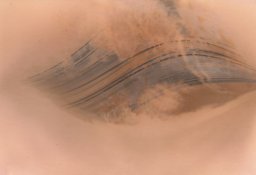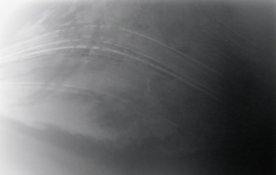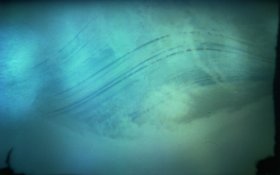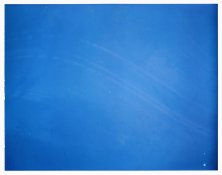NedL
Subscriber
This thread is about a first attempt to make an analog positive solargraph. I chose a solargraph that I didn't care about to do these experiments. It was made on a 3.5 x 5 inch piece of Adorama RC VC paper exposed for a little over 9 months.
My goal is to make a positive image that I can legally display on APUG.... Usually I scan these and invert the colors using software, not very different from handling color negative film but there is no orange "mask".
Usually I scan these and invert the colors using software, not very different from handling color negative film but there is no orange "mask".
I should mention that I'm terrible at getting colors right when I scan, and although I tried to make these images look like they do in hand, some of them are a little off. Also, I don't own a film scanner, but just an el cheapo flatbed that I got on sale for $28.
Step 1, I've worked out a way to fix solargraphs, so I did that. It involves a very very slight amount of development, followed by normal rapid fixer. Here's what we are starting with:

The background is just a bit lighter than this shows, but it is pretty close. The first thing I tried was a contact lumen print onto photo paper. You can probably guess what happened by the color... it was very effective at blocking the light. After 2 hours under a cfl there was an even light pink. So I put it under a UV BLB overnight, and only got a somewhat darker lavender-grey color, but no hint of any image. This background color blocks the light that photo paper is sensitive to just as well as the sun streaks.
Next try: I took my macro pinhole camera and made an "enlargement" of a portion of the solargraph onto 5x7 paper. I like the result, but part of the fun of solargraphs is all the color:

Now we get to my wacko idea: I made a copy of the solargraph onto FP-100C instant film. For this experiment, I used my instant film pinhole camera to make the copy... maybe in the future I will use a lens:

That actually looks pretty neat in hand. It is a little greener than my scan shows, and it does not have so strong a brownish cast on the right. It looks like a solargraph underwater in a blue-green sea!
Next I "reclaimed" the negative ( which contains a positive of the solargraph ) by removing the "black goo" with bleach. This went well but the "negative" is a bit thin and low contrast. I put it into my enlarger and projected it directly onto a pack of FP-100C on my baseboard, hoping to transfer the positive image into something I can hold in my hand and legally upload to APUG. The result was not very good but it is a positive image:

It's maybe a little better than this scan shows, but not much.
Anyway, that's what I tried today. At the end of it all, my favorite is still the original solargraph, and I'm going to make some bigger cameras to try to make 8x10 or 11x14 versions....
My goal is to make a positive image that I can legally display on APUG....
 Usually I scan these and invert the colors using software, not very different from handling color negative film but there is no orange "mask".
Usually I scan these and invert the colors using software, not very different from handling color negative film but there is no orange "mask".I should mention that I'm terrible at getting colors right when I scan, and although I tried to make these images look like they do in hand, some of them are a little off. Also, I don't own a film scanner, but just an el cheapo flatbed that I got on sale for $28.
Step 1, I've worked out a way to fix solargraphs, so I did that. It involves a very very slight amount of development, followed by normal rapid fixer. Here's what we are starting with:

The background is just a bit lighter than this shows, but it is pretty close. The first thing I tried was a contact lumen print onto photo paper. You can probably guess what happened by the color... it was very effective at blocking the light. After 2 hours under a cfl there was an even light pink. So I put it under a UV BLB overnight, and only got a somewhat darker lavender-grey color, but no hint of any image. This background color blocks the light that photo paper is sensitive to just as well as the sun streaks.
Next try: I took my macro pinhole camera and made an "enlargement" of a portion of the solargraph onto 5x7 paper. I like the result, but part of the fun of solargraphs is all the color:

Now we get to my wacko idea: I made a copy of the solargraph onto FP-100C instant film. For this experiment, I used my instant film pinhole camera to make the copy... maybe in the future I will use a lens:

That actually looks pretty neat in hand. It is a little greener than my scan shows, and it does not have so strong a brownish cast on the right. It looks like a solargraph underwater in a blue-green sea!
Next I "reclaimed" the negative ( which contains a positive of the solargraph ) by removing the "black goo" with bleach. This went well but the "negative" is a bit thin and low contrast. I put it into my enlarger and projected it directly onto a pack of FP-100C on my baseboard, hoping to transfer the positive image into something I can hold in my hand and legally upload to APUG. The result was not very good but it is a positive image:

It's maybe a little better than this scan shows, but not much.
Anyway, that's what I tried today. At the end of it all, my favorite is still the original solargraph, and I'm going to make some bigger cameras to try to make 8x10 or 11x14 versions....
Last edited by a moderator:






